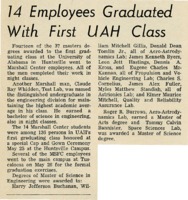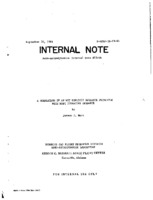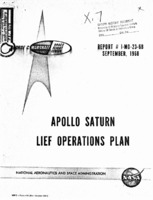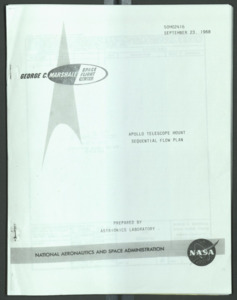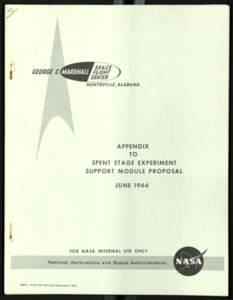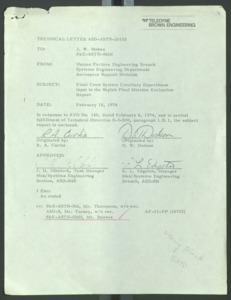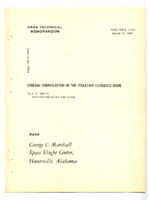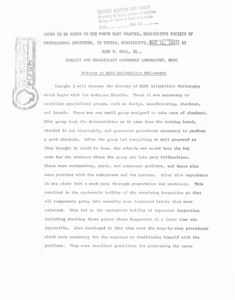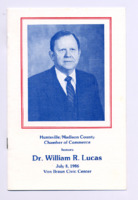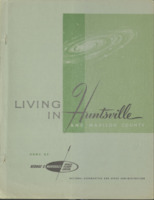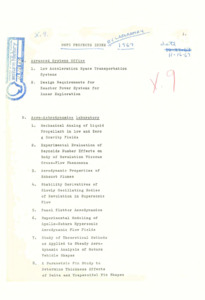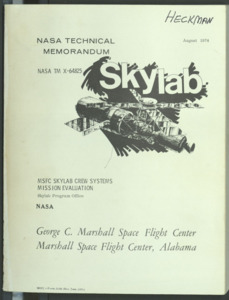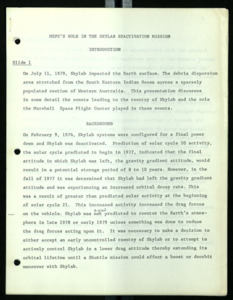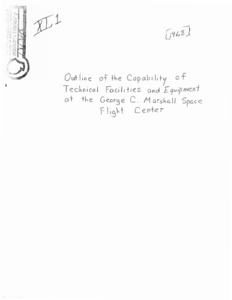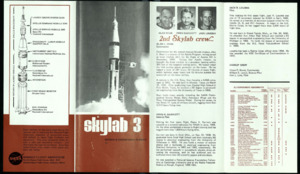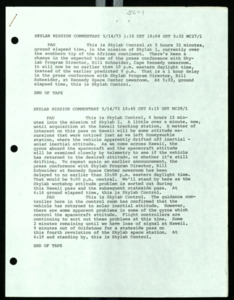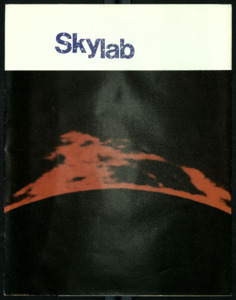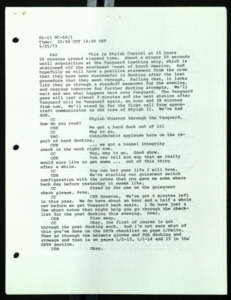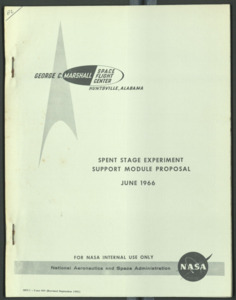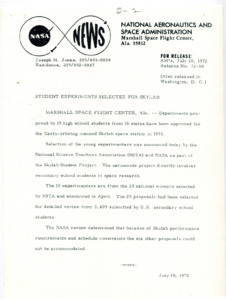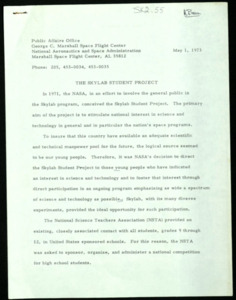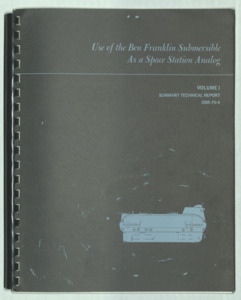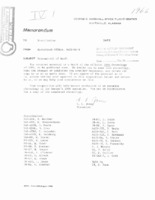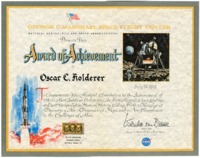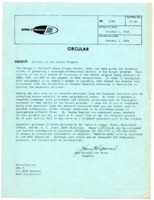
Browse Items (96 total)
Sort by:
-
"14 Employees Graduated With First UAH Class."
Clipping from the Marshall Star, May 29, 1968, vol. 8, no. 36. -
"A Comparison of an MIT Explicit Guidance Principle with MSFC Iterative Guidance."
From the summary: "Both [guidance] schemes steer toward a specified end point. The MIT scheme uses thrust to cancel out the effective gravity, a nonlinear term, which may be inefficient in certain cases. The MSFC scheme is more closely connected with calculus of variations and optimization theory in a reasonable degree of approximation." -
"Apollo Saturn LIEF Operations Plan."
This paper identifies the support functions performed by MSFC through the Launch Information Exchange Facility (LIEF) during the Apollo Saturn Mission Operations and other facilities required to carry out these functions. It also identifies mission specific documents required for operation. Note that page 20 is missing. -
"APOLLO TELESCOPE MOUNT SEQUENTIAL FLOW PLAN."
This is a manual that describes the handling and use of the Apollo Telescope Mount prior to launch. -
"Final Crew System Corollary Experiment Input to the Skylab Final Mission Evaluation Report."
This report describes the experiments onboard Skylab, what the data the experiments gather indicates, and the equipment that the experiments utilize. This includes the spider experiment. -
"General Formulation of the Iterative Guidance Mode."
From the abstract: "This report discusses the iterative guidance mode and its application to three-dimensional upper stage vacuum flight. It is an inertial or closed system mode in that the only inputs required after liftoff are available from the onboard navigation system. That is, the iterative scheme computes steering commands as a function of the state and of the vehicle - velocity, position, longitudinal acceleration, and gravitational acceleration - and the desired cutoff conditions. The guidance commands are updated each guidance cycle, using the updated state of the vehicle. The iterative guidance scheme is a path adaptive guidance scheme in that it will retain its optimization properties under all expected types and magnitudes of vehicle perturbations without any loss in accuracy at liftoff." -
"History of MSFC Reliability Philosophy."
Paper given to North East Chapter , Mississippi Society of Professional Engineers. Essay discussing the history of the MSFC Reliability Philosophy. -
"Huntsville/Madison County Chamber of Commerce honors Dr. William R. Lucas."
From a dinner held in honor of the retirement of MSFC director William R. Lucas in 1986. It includes a biographical sketch and photographs of Lucas. -
"Living in Huntsville and Madison County: Home of George C. Marshall Space Flight Center."
This pamphlet includes a memo to "Key MSFC Employees" from M. Keith Wible, Chief of the Manpower Utilization and Administration Office at Marshall Space Flight Center. -
"MSFC projects index by laboratory."
Project indexes included for: Advanced Systems Office, Aero-Astrodynamics Laboratory, Astrionics Laboratory, Computation Laboratory, Engineering Computation Division, Manufacturing Engineering Laboratory, Propulsion and Vehicle Engineering Laboratory, Quality and Reliability Assurance Laboratory, Research and Development Operations, Research Projects Laboratory, and Test Laboratory. -
"MSFC SKYLAB CREW SYSTEMS MISSION EVALUATION."
This is a hardware evaluation and assessment of the skylab habitat systems based on the feedback from the Skylab crews. -
"Outline of the capability of technical facilities and equipment at the George C. Marshall Space Flight Center."
Outline of the equipment present at George C. Marshall Space Flight Center. -
"skylab 3 SCIENCE & ENGINEERING IN ORBIT" brochure.
This brochure describes the duties and responsibilities of the Skylab 3 crew, including experiments and repairs. -
"Skylab Mission Commentary 5/14/73 1:10 CST 18:04 GET 5:32 MC27/1" - "Skylab Mission Commentary 5/15/73 1:20 CST MC38/1."
This mission commentary depicts NASA's attempts to alleviate some of the temperature issues caused by the broken micrometeoroid shield on Skylab 1. -
"SKYLAB WORKING ON A NEW FRONTIER."
This article describes the technical aspects of all of the Skylab missions, with a focus on readability for the public. -
"SkyLab: An Oral History of America's First Space Station."
This video was released in conjunction with Skylab's 30th anniversary in 2003. It contains video footage from the Skylab program as well as interviews with those associated with the program.Tags Oral History -
"Skylab" Poster.
This poster is a comprehensive depiction of the Skylab space habitat as a whole, as well as a general summary of the Skylab program as a whole, including descriptions of the roles and responsibilities of the organizations involved in the Skylab program. -
"SL-II MC-60/1 Time: 22:50 CDT 14:50 GET 5/25/73" - "SL-II MC 64/1 Time: 01:25 CDT 17:25 GET 5/25/73."
This mission commentary depicts Skylab 2 docking with Skylab 1. This mission commentary also depicts the Skylab 2 crew beginning work on resolving the solar panel and micrometeoroid shield problems. -
"STUDENT EXPERIMENTS SELECTED FOR SKYLAB."
Students involved in the student experiment selection are: Bochsler, Daniel C., Converse, Vincent W., Crites, Troy A., Dunlap, W. Brian, Hamilton, John C., Hopfield, Alison, Jackson, Kathy L., Johnston, Roger G., Leventhal, Jeanne L., Meister, Todd A., Miles, Judith S., Peltz, Cheryl A., Quist, Terry C., Reihs, Joe W., Schlack, Donald W., Wordekemper, Joel G., Shannon, Neal W., Staehle, Robert L., Zmolek, Joe B. -
"The Skylab Student Project."
Students involved in the student experiment selection are: Bochsler, Daniel C., Converse, Vincent W., Crites, Troy A., Dunlap, W. Brian, Hamilton, John C., Hopfield, Alison, Jackson, Kathy L., Johnston, Roger G., Leventhal, Jeanne L., Meister, Todd A., Miles, Judith S., Peltz, Cheryl A., Quist, Terry C., Reihs, Joe W., Schlack, Donald W., Wordekemper, Joel G., Shannon, Neal W., Staehle, Robert L., Zmolek, Joe B. Students whose experiments were held in consideration for future programs are Stein, Keith L., Brandt, Kent M., McGee, Keith, Sherhart, Kirk M., Merkel, Gregory A., Healy, James E. -
Dr. Charles Lundquist (Space History Interviews)
Interview by David Christensen on February 10, 2005Tags Oral History -
Transplanted Rocket Pioneers.
The information in this dataset is reproduced from Charles Lundquist's 2014 monograph Transplanted Rocket Pioneers. The information includes biographical and professional information that he compiled to produce the book. Each individual represented in the dataset also has a vertical file in the Lundquist Collection at UAH.
Transplanted Rocket Pioneers is a recognition of the early members of the von Braun rocket team, many of whom were key players in the successful moon landing. Many historians conclude that the lunar missions of the Apollo Program could not have been possible without the leadership and experience provided by a corps of engineers, scientists and managers transplanted from Europe to the Unites States after World War II. This fact motivated Dr. Lundquist to deposit this work in the Archives of the Library at the University of Alabama in Huntsville by assembling a file on each of the individuals who came from Europe to participate in the rocketry activities in Huntsville, or, in a few cases, individuals who had other ties to Huntsville.
This dataset includes a standard one-page summary sheet for each subject. Although most sheets are relatively complete, some data are still missing.
The first two lines on each page records fundamental identification information:
Family name Date of birth Place of birth Given names Date of death Place of death
The next standard entry is a statement of the extent of the Archives Holdings, either i) A primary collection of documents housed in one or more banker boxes, usually a separate individual collection ii) A secondary collection in a standard archive box, or iii) a file folder. Next, if there is an oral or video history for the individual, this fact is noted. A statement about the highest education levels of the individual follows. The next five entries, in chronological order, record whether the individual participated in activities at five sites:
1. Raketenflugplatz-Kummersdorf: Individuals engaged in the activities at these sites of early rocket development experiments sponsored first by VfR and subsequently by the German Army.
2. Peenemünde: Included here are individuals who participated in Peenemünde programs under several auspices, including as Army civilian employees, as members of the German military, as contractor employees on site or visiting as needed, and as university employees collaborating as required.
3. Fort Bliss: Individuals who were brought to Fort Bliss from 1945 to 1950.
4. GMDD-ABMA: Individuals who came to Huntsville, Alabama to work for the US Army rocket programs in the decade 1950 to 1960.
5th MSFC: Individuals who were employed by the NASA Marshall Space Flight Center in the 1960s.
Some people had various relationships with UAH and that is so noted. Additionally, a statement of immigration details is noted if pertinent. Finally, a great variety of incidental information is included under Incidental Remarks.
UAH Special Collections welcomes additions of biographical materials to the vertical file in the Charles Lundquist Collection. Please note that the work is that of Dr. Lundquist and may contain errors or omissions which are solely the product of his work on the project, as noted in the introduction of the work.: " Finally, it is pertinent to note that any document containing large files will surely have some mistakes or omission. Any errors are the responsibility of the author alone." As was the wish of Dr. Lundquist, we will strive to make factual corrections to the online copy when necessary.
-
1966 Chronology of Marshall Space Flight Center.
This draft copy of the chronology includes a memorandum from Marshall Historian L. L. Jones of the Historical Office. -
Abbreviated timeline of the Apollo 11 mission.
The timeline includes a memorandum from Friedjof A. Speer, manager of the Missions Operations Office, to employees of Marshall Space Flight Center. Speer notes that "astronaut Neil Armstrong is scheduled to be the first man to step onto the moon's surface." The timeline outlines the entire mission from liftoff at 8:32 AM on Wednesday, July 16, 1969 to splashdown at 11:49 AM on Thursday, July 24, 1969. -
Alex McCool.
Interview between Bob Ward and Alex McCool. Topic covered included Wernher von Braun's interactions with Marshall personnel as well as how history will interpret von Braun. Both sides of tape.Tags Oral History -
C.E. "Ed" Monroe Jr., David Christensen.
Phone call between Bob Ward and C.E. Monroe. Short talk centers around Wernher von Braun and living on Monte Sano in Huntsville, Alabama. All of side 1.Tags Oral History -
Chas. Hewitt.
Phone conversation between Bob Ward and Mr. Hewitt. Hewitt speaks about Wernher von Braun's gift for oration and some of the stories he shared about his past. Full side of tape.Tags Oral History -
Chuck Lundquist, Werner Dahm.
Bob Ward calls Chuck Lundquist to talk about and stories he knows relating to Wernher von Braun. Lundquist relates a few tales relating to von Braun's work in the early days of NASA as well as his family and the way he handled meetings. Entirety of side 1.Tags Oral History -
Circular announcing MSFC's involvement with the documentation of the Saturn program at the UAH Research Institute.
The documentation noted in the circular is available at UAH Archives and Special Collections in the Saturn V Collection. -
Crowds and television cameras wait for President John F. Kennedy during his second visit to Huntsville.
Kennedy visited Huntsville on Armed Forces Day 1963. He first visited the area on September 11, 1962. -
Dorette Schlidt, Bill Lucas, Jim Odom, William Pickering, Dr. A.K. Thiel, Joe Jones.
Phone call between Dorette Schlidt and Bob Ward on different aspects and emotions of the von Brauns leaving Huntsville, Alabama. Side 1 thru 6:00.Tags Oral History -
Dr. Adolf Thiel, Jim Shepherd, Bob Lindstrom.
Phone Conversation with Dr. Adolf Thiel about Dr. Wernher von Braun and their time working together at Peenemünde and in the United States. Side 1 begninning to 14:18.Tags Oral History -
Dr. William Lucas.
Interview with Dr. William Lucas on Wernher von Braun, comparing and contrasting him to Robert Goddard and setting up the University of Alabama in Huntsville, along with other stories. Both sides of tape.Tags Oral History -
Dr. William Pickering, Dr. A.K. Thiel, Ed Mohlere.
Phone call between Dr. William Pickering and Bob Ward on encounters Pickering had with Wernher von Braun. Not very audible. Side 1 up to 19:00.Tags Oral History -
Ed Barisford, Al Berisford, Ralph Petroff.
Phone call from Bob Ward to Ed Barisford regarding any stories involving Wernher von Braun he knew. Barisford related a couple stories about von Braun's flying habits, which was his primary connection to Barisford. Side 1 to 32:00.Tags Oral History
